Вы здесь
Peak of Revolution.

Peaks of Yazgulemskiy ridge.
“Dust and gasoline ... vanity, talk.
Glowing with the full comfort of the apartment.
Mountains are shrouded in wet fog
Wise - Doze on the world.
Torn shreds swirl in the gorges.
Only a century old, dank, will disappear.
The wind will swing a blanket - a blizzard
And he’ll throw it on the shoulders of the giants.
Slightly open the shaggy eyelids,
Khan-Tengri Looks - Up to the Plain
Quiet. White. Do not see a person.
Snoozing Peaks "
Sarym Kuderin, 1962.
Climbing peak of Revolution.
The peak of the Revolution is located in the Yazgulemsky Range in the Pamirs. The story of the conquest of the peak of the Revolution began in the mid-50s of the XX century. During the ascents, there were three characteristic periods - three rounds of the struggle for victory over the formidable giant of the mountains: eastern - 1952 - 1960; North - 1962 - 1967; Southern - 1968 - 1969.
The view from the top offers a magnificent - in the north, literally underfoot - the wide radiation of the upper reaches of the largest valley glacier in the world, bearing the name of one of the first explorers of this mountain region - A.P. Fedchenko.
Gathering in a three-kilometer wide channel, its ice masses slide northward. Its snow-white smooth forms are gently outlined against the background of a thick blue sky, tucked up against the horizon with a light milky haze.
This peak is visible from here distinctly and almost nearby, although it is not less than 120 kilometers away. In the north-west, the peak of Communism is the highest peak of the CIS mountains. Against its background, even such a powerful peak as the peak of Russia, with a height of 6852 meters above sea level, somehow seems to be insignificant, the massive and heavy-looking Garmo peak with a height of 6595 meters above sea level.
In the same Yazgulemsky ridge, where the peak of the Revolution is located, there is a peak named after 26 Bakinsky Commissars, with a height of 6834 meters above sea level. Behind it, to the west, is the two-headed peak of the Paris Commune, 6537 meters above sea level.
In the south, behind the wide ribbon of the Yazgulem-Dara glacier and behind the more remote Rushan ridge, snow caps of Karl Marx peaks, 6,726 meters above sea level and Friedrich Engels, 6,510 meters above sea level, rise in the latitudinal Shakhdara ridge.
Behind them, as if resting on the distant blue of the sky, there are six - and the seven-thousandths of the Hindu Kush, to which at least 250 kilometers. In the east, over the vast expanses of the mountains of Central Asia, the peaks of Kungur-tube and Muztagat, already familiar to the Soviet alpinists, rise.
In 1952, an attempt was made to climb the peak of the Revolution of the expedition of trade union climbers, but it was not achieved. The round is eastern. In 1954, an expedition of union climbers headed by A. Ugarov again arrived here.
In the preceding 1953, the expedition led by him led an ascent to the seven thousand meters high Pamir - the peak of E. Korzhenevskaya, with a height of 7105 meters above sea level. Having made a tiring journey along the Grum-Grzhimailo glacier, bypassing icefalls, glacial lakes, deep cracks, they reached the upper circus, which represented an extensive, almost horizontal snow plateau at an altitude of about 6000 meters above sea level.
The storm was prevented by a suddenly raining weather. Only on August 15 a group of eleven climbers went on the assault on the summit. Having overcome the steep slope of the north-eastern spur, they were not far from the top.
On August 17, despite the snowfall that came up with a strong wind, the climbers first climbed to the top of the peak of the Revolution. Years passed. For five years no one dared to repeat the ascent of the first conquerors of the peak of Revolution.
It seemed that the Soviet climbers limited themselves to this only assault on the almost seven-kilometer summit. Apparently, therefore, the ascent of the wintering team of the Fedchenko Glacier meteorological station at first went unnoticed.
And the "owners" of these places, headed by the famous Uzbek mountain conqueror V. Nozdryukhin decided on this. They climbed from Fedchenko Glacier along its right tributary, Vitkovsky Glacier, to the High Wall ridge, crossed the bridge in this ridge and entered the circus of the Grum-Grzhimailo Glacier.
From here they repeated the path of the pioneers and became the winners of the peak of the Revolution. A year later (1960), Leningraders led by S. Savvon launched an assault on the peak of the Revolution from the same eastern direction.
They, like the pioneers, successfully entered the upper circus along the Grum-Grzhimailo glacier. But from here the Leningraders did not go the beaten path along the north-east ridge. They chose the eastern ridge.
Here they are faced with powerful "gendarmes", failures, large and often bilateral eaves. On the "gendarmes" had to use hooks. Frost and strong wind interfered. Despite all this, on August 26, Leningraders were at the top.
The break lasted only one year. In 1962, the talented Soviet climber L. Myshlyaev led his friends to the summit along the complex northern wall of the massif. The decision was bold and risky. The rock wall, along which the athletes were going to pave the way to the top, steeply rose above the headwaters of the Fedchenko Glacier at an altitude of 5300 meters above sea level. Her dark crowd, powdered with snow, looked frightening.
Here, on the way of the climbers, the rock walls of such steepness and complexity that they often encountered in the Caucasus got up. But there the height does not oppress, such low temperatures do not slow down.
At almost every meter, the walls were hooked. Insurance is the most thorough. More than a kilometer and a half wall required not only high sportsmanship, but also the special persistence inherent, perhaps, only to climbers.
The wall did not give up immediately. She posed climbers one difficulty after another, which they persistently and skillfully overcame. Finally, the wall was left behind. Climbers stood at the highest peak of the Revolution
This assault was rated by experienced high-altitude workers as excellent. And again, a five-year break, as in the Eastern round. Only in 1967, climbers again appeared in the upper reaches of the Fedchenko glacier, above which the northern wall of the massif of the peak of the Revolution rises.
And two teams at once. One of them is the army team led by V. Nekrasov, and the second is the Chelyabinsk climbers led by A. Kuznetsov. Together they carefully and persistently studied the magnificent massif with a formidable wall.
Now she looked stubborn, abundantly powdered with fresh snow, even more severe and impregnable. The first came the army team. Athletes had to clear the deepening of the rocks from the snow in order to find cracks for driving hooks.
Snow melted in the sun and stuck to my hands. The ropes became wet. It was difficult to work with them. Hands desperately froze. The walls, so necessary for climbers, did not allow the wall to rock. The lift voltage increased with height.
After a difficult and difficult climb along the wall, tired but satisfied army men finally stood on top of the winners.

Authority:
"The conquered peaks." 1970 1971 Thought Publishing House, Moscow.







